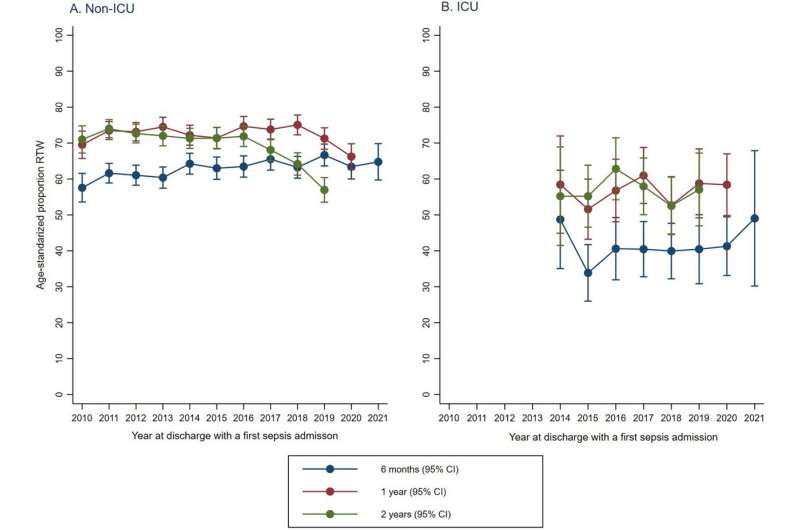This article has been reviewed according to Science X's editorial process and policies. Editors have highlighted the following attributes while ensuring the content's credibility:
fact-checked
peer-reviewed publication
trusted source
proofread
Blood poisoning keeping many people out of work

A few years ago, the World Health Organization estimated that blood poisoning, or sepsis, is involved in 1 in 5 deaths around the world; 11 million people die from sepsis each year, of which nearly 3 million are children.
This is also a problem in Norway, with thousands of people affected every year.
"Sepsis is a severe immunological overreaction to an infection. It causes the body's organs to fail," says Nina Vibeche Skei. She is a doctoral research fellow at the Norwegian University of Science and Technology (NTNU) and a senior anesthetist at Levanger Hospital.
In Norway, 3,000 people die every year from sepsis.
"Many people believe that sepsis only affects the elderly, but a third of those who survive are between the ages of 18 and 60, and this has many consequences," says doctoral research fellow Skei.
Many years of diminished health
Patients who survive sepsis may have health problems and reduced quality of life for years after they are discharged. Many develop a new chronic disorder or exacerbation of existing chronic conditions, or ailments due to organ failure and intensive care.
"Even everyday activities can become a challenge," says Skei.
As a result, many people do not return to work after having sepsis, but until now, we have not known how many.
"We investigated the percentage of sepsis patients who returned to work in Norway," says Lise Tuset Gustad. She is a researcher at the Faculty of Nursing and Health Sciences at Nord University and Levanger Hospital. The study is published in the journal Critical Care.
High levels of occupational disability among people with sepsis
The research group they were part of retrieved figures from the Norwegian Patient Registry and from the Norwegian Labor and Welfare Administration's information on absence due to illness. The figures included 36,000 sepsis patients aged 18 to 60. The researchers looked at whether they had returned to work six months, one year and two years after they had been discharged from hospital.
After six months, fewer than 59% of the patients had returned to work. After one year, just over 67% were back at work. However, after two years, the number was down to just over 63%.
In other words, almost 4 out of 10 of those who had had sepsis were out of work two years after contracting the illness.
Several determining factors
Several factors come into play regarding who is able to return to work after having sepsis.
"Those who fared best were young people with few additional chronic diagnoses and less extensive organ failure," says Skei.
The 50- to 60-year-olds were 31% less likely to return to work than people aged 18 to 30. People with a chronic illness were 54% less likely to return to work, compared with those without a chronic illness. People who had two organs that failed were 40% less likely to return to work than those who suffered only one organ failure.
"In addition, people who required intensive care had almost a 50% reduced chance of returning to work, compared with those who were admitted to a ward," says Gustad.
This is because the individuals who require intensive care often have more severe sepsis. Only 52% of those admitted to an intensive care unit, compared with 64% of those admitted to a ward, were back at work two years after discharge.
The researchers also investigated people who contracted sepsis as a result of COVID-19. This group was 31% more likely to return to work than the rest of the patients with sepsis.
No improvement
"The main finding of this study is that sepsis greatly reduces the chances of returning to work," says Skei.
Unfortunately, there is nothing to indicate that we have become better in Norway at getting sepsis patients back to work. The figures were from the period 2010 to 2021, enabling the researchers to document changes.
"Developments over the past decade show no improvement. In fact, the percentage of people who were in work two years after discharge from a hospital ward fell from 70% in 2016 to 57% in 2019. The reasons for this should be investigated further. We can then implement targeted measures to improve the consequences of sepsis," says Gustad.
More information: Nina Vibeche Skei et al, Return to work after hospitalization for sepsis: a nationwide, registry-based cohort study, Critical Care (2023). DOI: 10.1186/s13054-023-04737-7




















